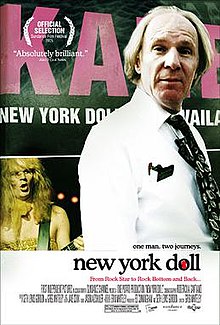New York Doll: Difference between revisions
m →Plot: clean up; http→https for The New York Times. using AWB |
Official website is gone; taken over by a spam site. Link removed. |
||
| Line 19: | Line 19: | ||
==Plot== |
==Plot== |
||
The film details the history of both the New York Dolls and one of its members, Arthur "Killer" Kane. The film narrates the history of the band from its formation in 1972, through its drug problems and the deaths of several of its members. The central focus of the film, however, is Arthur's life after conversion to [[The Church of Jesus Christ of Latter-day Saints]] after struggles with [[alcoholism]], [[drug abuse]], an attempt at [[suicide]], and a beating with a baseball bat that, contrary to popular belief, did not happen during the Rodney King riots |
The film details the history of both the New York Dolls and one of its members, Arthur "Killer" Kane. The film narrates the history of the band from its formation in 1972, through its drug problems and the deaths of several of its members. The central focus of the film, however, is Arthur's life after conversion to [[The Church of Jesus Christ of Latter-day Saints]] after struggles with [[alcoholism]], [[drug abuse]], an attempt at [[suicide]], and a beating with a baseball bat that, contrary to popular belief, did not happen during the Rodney King riots but left him near death and needing a long recovery.<ref name="KaneKane2009">{{cite book|author1=Arthur Kane|author2=Barbara Kane|title=I, Doll: Life and Death With the New York Dolls|url=https://books.google.com/books?id=m8WqcRw9zzwC&pg=PA222|accessdate=March 17, 2012|date=August 1, 2009|publisher=Chicago Review Press|isbn=978-1-55652-941-2|pages=222–}}</ref> |
||
As Kane struggles with both loneliness and poverty, he discovers that he will once again have a chance to perform with the Dolls in [[London]]. After overcoming his differences with former band member [[David Johansen]], Kane has a successful performance. Upon his return to Los Angeles, Kane contemplates touring with the reunited Dolls, but plans are cut short by his unexpected death from [[leukemia]]. |
As Kane struggles with both loneliness and poverty, he discovers that he will once again have a chance to perform with the Dolls in [[London]]. After overcoming his differences with former band member [[David Johansen]], Kane has a successful performance. Upon his return to Los Angeles, Kane contemplates touring with the reunited Dolls, but plans are cut short by his unexpected death from [[leukemia]]. |
||
| Line 37: | Line 37: | ||
}} |
}} |
||
*{{IMDb title|0436629}} |
*{{IMDb title|0436629}} |
||
*{{official website|http://www.newyorkdollmovie.com}} |
|||
*{{Rotten Tomatoes|new_york_doll}} |
*{{Rotten Tomatoes|new_york_doll}} |
||
Revision as of 01:37, 7 November 2017
| New York Doll | |
|---|---|
 | |
| Directed by | Greg Whiteley |
| Produced by | Ed Cunningham Seth Gordon |
| Starring | Arthur Kane David Johansen Sylvain Sylvain |
| Music by | Brett Boyett |
| Distributed by | First Independent Pictures Vivendi Entertainment |
Release date |
|
Running time | 75 minutes |
| Country | United States |
| Language | English |
New York Doll is a documentary based on the life of former New York Dolls member Arthur Kane. It was nominated for both a Satellite Award and a Grand Jury Prize at the Sundance Film Festival, where it premiered in 2005.
Plot
The film details the history of both the New York Dolls and one of its members, Arthur "Killer" Kane. The film narrates the history of the band from its formation in 1972, through its drug problems and the deaths of several of its members. The central focus of the film, however, is Arthur's life after conversion to The Church of Jesus Christ of Latter-day Saints after struggles with alcoholism, drug abuse, an attempt at suicide, and a beating with a baseball bat that, contrary to popular belief, did not happen during the Rodney King riots but left him near death and needing a long recovery.[1]
As Kane struggles with both loneliness and poverty, he discovers that he will once again have a chance to perform with the Dolls in London. After overcoming his differences with former band member David Johansen, Kane has a successful performance. Upon his return to Los Angeles, Kane contemplates touring with the reunited Dolls, but plans are cut short by his unexpected death from leukemia.
The film features interviews with Morrissey, who arranged the reunion show, as well as other artists such as Chrissie Hynde and Bob Geldof.
New York Doll was shot on digital camcorders with an aspect ratio of 1.78:1.[2][3][4]
It scored a 90% on Rotten Tomatoes out of 51 reviews.[5]
References
- ^ Arthur Kane; Barbara Kane (August 1, 2009). I, Doll: Life and Death With the New York Dolls. Chicago Review Press. pp. 222–. ISBN 978-1-55652-941-2. Retrieved March 17, 2012.
- ^ DVD Talk
- ^ IGN Review
- ^ New York Times
- ^ "New York Doll (2004)". Retrieved March 17, 2012.
